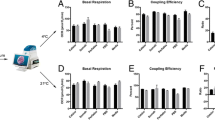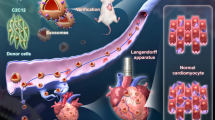Abstract
In cardiac transplantation, the donor heart is exposed to severe hypothermic and ischemic conditions. The purpose of the present study was to evaluate the functional and biochemical effects on cardiac myocytes cultured under hypothermic conditions. Cardiac myocytes were isolated from neonatal rat ventricles and cultured for 4 days, then incubated (1.5×106 myocytes/culture flask) for 24 h in media at 4, 10, 15, 20, and 37°C. In addition, myocytes were incubated at 4°C for 6, 12, 18, 24, 36, and 48 h. After each incubation, creatine phosphokinase (CPK) and lactate dehydrogenase (LDH) were measured and the myocytes then cultured for an additional 24 h at 37°C to evaluate the recovery of the myocyte beating rate. The recovery ratio of the myocyte beating rate following 24 h of varying temperature incubations was complete for the 10, 15, 20, and 37°C groups, although it was markedly decreased in the 4°C group, at 25.1% of the control; taken as the beating rate prior to hypothermic incubation. The release of CPK and LDH in the 4°C group showed a three-fold increase compared to the other four groups, with a CPK of 147.2 mIU/flask and a LDH of 487.5 mIU/flask. The recovery of the beating rate for varying time incubations at 4°C was complete for the 6- and 12-h groups, but decreased significantly in the other four groups, being 59.0% at 18 h, 28.2% at 24 h, 16.3% at 36 h, and 0% at 48 h. The CPK and LDH levels increased gradually over 24 h, then markedly at 36 and 48 h, to 301.3 and 940.5 at 36 h, and 1143.6 and 1942.9 at 48 h, respectively. Thus, 4°C hypothermia induced myocyte injury both functionally and biochemically which increased with the incubation time.
Similar content being viewed by others
References
Burt JM, Copeland JG (1986) Myocardial function after preservation for 24 hours. J Thorac Cardiovasc Surg 92:238–246
Takahashi A, Braimbridge MV, Hearse DJ, Chambers DJ (1991) Long-term preservation of the mammalian myocardium. Effect of storage medium and temperature on the vulnerability to tissue injury. J Thorac Cardiovasc Surg 102:235–234
Wicomb W, Cooper DKC, Hassoulas J, Rose AG, Barnard CN (1982) Orthotopic transplantation of the baboon heart after 20 to 24 hours' preservation by continuous hypothermic perfusion with an oxygenated hyperosmolar solution. J Thorac Cardiovasc Surg 83:133–140
Warner M, Guerraty A, Alivizatos P, Choi SC, Hudson B, Lower RR, Hess ML (1982) Assessment of myocardial subcellular function after 24 hours of in vitro preservation and transplantation. J Thorac Cardiovasc Surg 83:290–297
Jarmakani JM, Nakazawa M, Nagatomo T, Langer GA (1978) Effect of hypoxia on mechanical function in the neonatal mammalian heart. Am J Physiol 235:H469-H474
Bove EL, Gallagher KP, Drake DH, Lynch MJ, Fox M, Forder J, Boling SF, Shlafer M (1988) The effect of hypothermic ischemia on recovery of left ventricular function and preload reserve in the neonatal heart. J Thorac Cardiovasc Surg 95:814–818
Grice WN, Konishi T, Apstein CS (1987) Resistance of neonatal myocardium to injury during normothermic and hypothermic ischemic arrest and reperfusion. Circulation 76[Suppl V]:V150–V155
Klein I, Daood M (1985) Regulation of the growth of nonmuscle heart cells in culture. In Vitro Cell Dev Biol 21:693–696
Suzuki T, Ohta M, Hoshi H (1989) Serum-free, chemically defined medium to evaluate the direct effects of growth factors and inhibitors on proliferation and function of neonatal rat cardiac muscle cells in culture. In Vitro Cell Dev Biol 25:601–606
Blondel B, Roijen I, Cheneval JP (1971) Heart cells in culture: A simple method for increasing the population of myoblasts. Experientia 27:356–358
Polinger IS (1970) Separation of cell types in embryonic heart cell culture. Exp Cell Res 63:78–82
Yagev S, Heller M, Pinson A (1984) Change in cytoplasmic and lysosomal enzyme activities in cultured rat heart cells: The relationship to cell differentiation and cell population in culture. In Vitro Cell Dev Biol 20:893–898
Laarae AVD, Hollaar L, Kokshoorn LJM, Witteveen SAGJ (1979) The activity of cardio-specific isoenzymes of creatine phosphokinase and lactate dehydrogenase in monolayer cultures of neonatal rat heart cells. J Mol Cell Cardiol 11:501–510
Acosta D, Puckett M, McMillin R (1978) Ischemic myocardial injury in cultured heart cells: Leakage of cytoplasmic enzymes from injured cells. In Vitro Cell DeV Biol 14:728–732
Bers DM, Bridge JHB, Spizer KW (1989) Intracellular Ca2+ transients during rapid cooling contractures in guinea-pig ventricular myocytes. J Physiol 417:537–553
Hryshko LV, Stiffel V, Bers DM (1989) Rapid cooling contractures as an index of sarcoplasmic reticulum calcium content in rabbit ventricular myocytes. Am J Physiol 257:H1369-H1377
Author information
Authors and Affiliations
Rights and permissions
About this article
Cite this article
Orita, H., Fukasawa, M., Hirooka, S. et al. A cardiac myocyte culture system as an in vitro experimental model for the evaluation of hypothermic preservation. Surg Today 23, 439–443 (1993). https://doi.org/10.1007/BF00309503
Received:
Accepted:
Issue Date:
DOI: https://doi.org/10.1007/BF00309503




